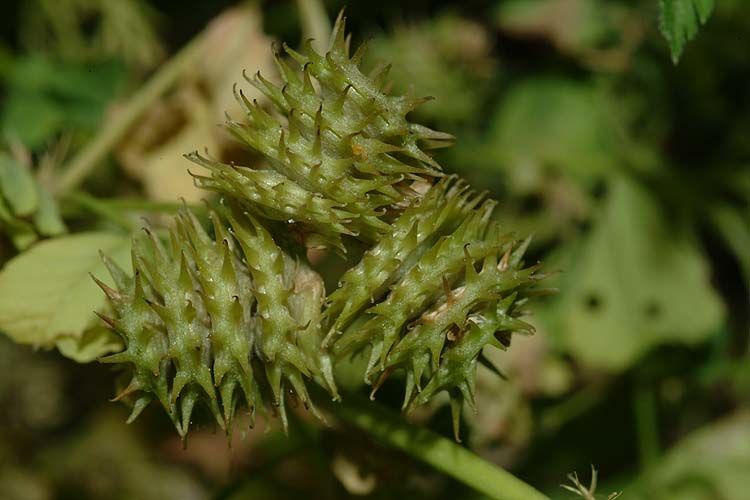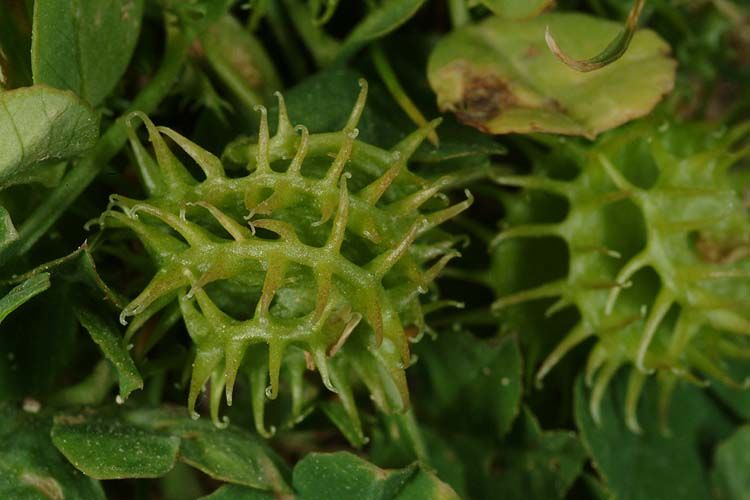Burclover
medicago polymorpha
Also known as: ["California burclover","California burclover","Bur clover"]
Overview
A low-growing, annual legume with trifoliate leaves and spiral-shaped burs that contain seeds. Native to the Mediterranean region and naturalized in many parts of the world.
Benefits & Perks
["drought tolerant","wildlife attractant (bees, butterflies, birds)"]
Botanical Classification
| Phylum: | Magnoliophyta |
| Class: | Magnoliopsida |
| Order: | Fabales |
| Family: | Fabaceae |
| Genus: | Medicago |
| Botanical Name: | Medicago polymorpha |
Plant Characteristics
Basic Information
- Category: Herbs & Weeds
- Suitable Location: garden bed or container in a sunny area
- Suitable For:
- Is Weed: No
- Allergenicity: low
Environmental Needs
- Climate: {"temperatureRange":"5–35°C"}
- Hardiness: {"zones":"8–10"}
- Misting: rarely required
- Drainage: Fast-draining to prevent root rot.
- Soil Type: Well-draining, loamy soil with added organic matter.
Maintenance Level
- Maintenance Level: very low
- Toughness Level: high
- Pruning Frequency: As needed, typically annually or after flowering.
- Pruning Intensity: Light to moderate; avoid heavy pruning unless rejuvenation is required.
Care Details
Ideal Sunlight Coverage:
Full sun (6–8 hours/day) is ideal, but tolerates partial shade. Adjust exposure based on seasonal light intensity.
Sunlight Tolerance Tips:
Acclimate plants gradually to intense sunlight to prevent scorching. For indoor placement, provide the brightest possible light; outdoors, ensure some afternoon shade in hot climates.
Care Requirements
Care Difficulty
very easyeasy
Sunlight
full sun to partial shade
Rotate plants for even light exposure; use sheer curtains to filter harsh sunlight; monitor for signs of sunburn.
Watering
every 7–10 days during active growth, reduce in winter
Water thoroughly until runoff, allow soil to dry slightly between waterings, and avoid overhead watering to prevent fungal issues.
Soil
well-drained, loamy soil with moderate fertility
pH: Slightly acidic to neutral (pH 6.0–7.0).
Avoid heavy clay soils; use raised beds for better drainage; test soil pH annually.
Temperature
Prefers moderate temperatures (60–75°F or 15–24°C). Tolerates mild frosts but thrives in cooler conditions.
Monitor temperature extremes; use mulch to regulate soil temperature; adjust watering with temperature changes.
Fertilizing
every 4–6 weeks during growing season
Apply fertilizer sparingly; focus on phosphorus and potassium rather than nitrogen; fertilize before active growth begins.
Propagation
Methods
Seeds or stem cuttings. Seeds are the most reliable method for this species.
Step-by-Step Propagation Guide
- Sow seeds shallowly or take 4–6 inch cuttings.
- Keep moist.
- Provide warmth and humidity.
- Transplant once rooted.
Best Time: Spring or early summer when temperatures are mild and growth is active.
Environment
Warm (65–75°F or 18–24°C), high humidity (70–80%), and bright indirect light.
Medium
Well-draining seed starting mix or cactus mix for cuttings.
Hormone
Not necessary for seeds; rooting hormone can aid cuttings but is optional.
Timeline
Seeds germinate in 1–3 weeks; cuttings root in 3–6 weeks and establish in 2–3 months.
Tools Needed
Seed trays, pots, rooting hormone (optional), misting bottle, heat mat.
Quick Tips
Scarify seeds for faster germination; use bottom heat for cuttings; maintain consistent moisture.
Pruning & Repotting
Pruning Guide
Method
Trim back leggy stems and remove spent flowers to encourage bushier growth.
Pruning Plan
Minimal pruning needed; focus on removing dead or damaged growth to maintain vigor.
Tools
Pruning shears, clean scissors.
Checklist
Sterilize tools; prune dead/damaged growth; remove spent flowers; shape lightly.
Repotting Guide
Best Season
Early spring before new growth begins.
Pot Size
Move to a pot one size larger (2–3 inches in diameter) than the current one.
Method
Use fresh, well-draining soil; gently tease out rootbound roots; ensure proper drainage holes.
Suggestions
Repot every 2–3 years or when roots fill the container to prevent congestion.
Checklist
Choose appropriate pot; prepare new soil; water plant before repotting; handle roots carefully.
Advanced Care Tips
Watering Mastery
Watering Checklist
Check soil moisture before watering; water deeply; ensure drainage; avoid wetting foliage.
How to Apply Water Properly
Water directly at the root zone, ensuring even saturation to a depth of 6–8 inches. Ensure excess water drains away to prevent waterlogging, and water early in the morning to minimize evaporation.
Watering Schedule Tips
Water deeply once a week during active growth; reduce frequency in winter to every 2–3 weeks. Adjust based on rainfall and soil moisture.
Soil Improvement
Add perlite or sand for drainage; incorporate compost for fertility; ensure good aeration.
Temperature Stress Management
Signs of Temperature Issues
Chlorosis or wilting in excessive heat; stunted growth or leaf drop in prolonged cold.
Cold Stress
Low temperatures slow growth and may cause leaf discoloration or dieback if below freezing.
Solution: Provide frost protection with row covers or mulch; move potted plants indoors during freezes.
Hot Stress
Excessive heat can lead to wilting, leaf scorch, or reduced flowering.
Solution: Increase watering frequency, provide shade during peak heat, and ensure good air circulation.
Fertilizing Guide
Fertilizing Checklist
Use balanced fertilizer; apply in spring; avoid nitrogen-heavy formulas; water after fertilizing.
Fertilizing Method
Use a balanced, slow-release fertilizer in early spring; avoid over-fertilizing, as Medicago polymorpha is a legume and fixes its own nitrogen.
Common Problems & Solutions
Toxicity Warning
Cats
Non-toxicMedicago polymorpha is not known to be toxic to cats. While cats are less likely to graze on this plant, ingestion is not expected to cause toxicity.
⚡ Toxic If:
Generally non-toxic
Dogs
Non-toxicMedicago polymorpha is not known to be toxic to dogs. It is commonly found in pastures and is often consumed by grazing animals without adverse effects.
⚡ Toxic If:
Generally non-toxic
Humans
Non-toxicMedicago polymorpha, commonly known as burclover, is generally considered non-toxic to humans. It is often used as a forage crop and in soil improvement due to its nitrogen-fixing capabilities.
⚡ Toxic If:
Generally non-toxic
Frequently Asked Questions
Q: Is Medicago polymorpha edible?
A: Yes, the leaves and young shoots are edible and can be used in salads or cooked as greens.
Q: Does Burclover fix nitrogen in the soil?
A: Yes, like other legumes, it has nodules on its roots that host nitrogen-fixing bacteria, improving soil fertility.
Q: Can Burclover be used as a cover crop?
A: Yes, it is often used as a cover crop to suppress weeds, prevent soil erosion, and enrich the soil with nitrogen.
Quick Reference
| Family: | Fabaceae |
| Care: | very easy |
| Light: | full sun to partial shade |
| Water: | every 7–10 days during activ |
Get Expert Care Tips
Download the Plantious app for personalized care reminders and plant identification!
Google Play App Store








